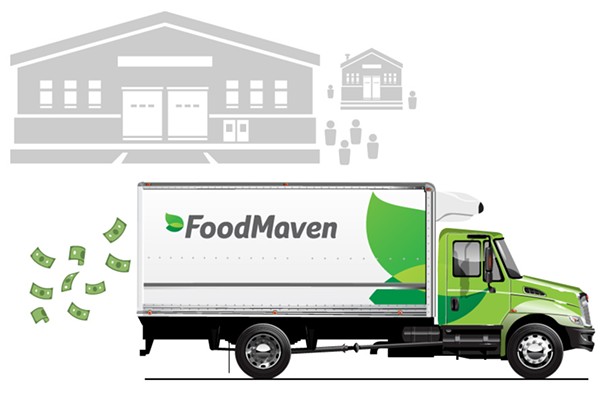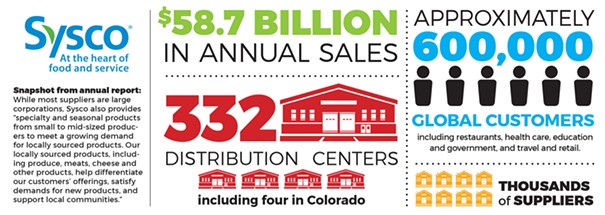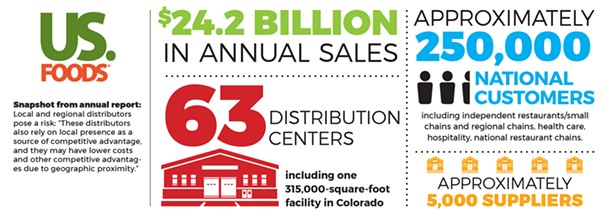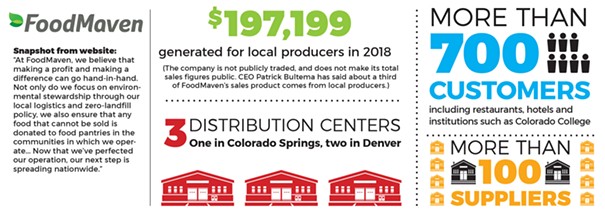Colorado Springs Independent: FoodMaven vs. Sysco and US Foods: How the young company stacks up
by Faith Miller | April 10, 2019
FoodMaven’s certainly done well for itself, but it has a long way to go before it reaches the scale of Sysco or US Foods, two massive publicly traded companies that make billions of dollars in annual sales.
Here’s some perspective:
FoodMaven’s experienced explosive growth
FoodMaven has come a long way from the days when it needed to share warehouse space with Care and Share. Last April, it moved into a 22,000-square-foot facility in northern Colorado Springs, and this month announced plans to add a downtown headquarters at 3 S. Tejon St. in the former headquarters of the Holly Sugar Corporation.
The company now employs more than 100 people and also has two warehouses in Denver. It counts more than 100 suppliers and over 700 buyers. Though it won’t report sales figures, it does claim to have generated $197,199 in revenue for local producers in 2018.
An additional $10 million this January from big-name investors like Walton family members and Tao Capital Partners (which has invested in Tesla, SpaceX and Uber) will help jump-start FoodMaven’s national expansion. The company also won a $350,000 Recycling Resources Economic Opportunity grant from the state for the second year in a row.
FoodMaven’s donation policy benefits suppliers
In addition to helping large buyers find a path to sustainable business practices, FoodMaven’s model can also connect nonprofits to big companies looking to offload product.
The company — a big donor itself — assists big-box grocery clients in donating excess product to food banks, including Care and Share Food Bank for Southern Colorado, the Marian House Soup Kitchen and Colorado Springs Food Rescue. Those corporations can, in turn, get tax credits from the donations.
This is a particular sticking point for Ranch Food Direct’s Mike Callicrate. He argues that by facilitating donations, FoodMaven is actually encouraging the food system to be wasteful, by removing the financial consequences.
“I walk in [a large grocery store] as someone in the business, thinking “What in the heck would be the waste in something like this to get the look of abundance?'” Callicrate says. “And when you consider that the higher they stack [produce and other perishables], the bigger their tax deduction is, and that it actually doesn’t cost them anything, then it starts to make sense.”
Another criticism of FoodMaven when they first started out was that the company was selling food “waste” that would otherwise likely be donated to charity. But overall, Care and Share hasn’t lost out on donations, says CEO Lynne Telford.
“In some cases [that is happening], but then in other cases they’ve connected us with new partners,” she says, “so all in all we haven’t seen a negative impact from them being in the market.”
Care and Share allowed FoodMaven to use some of its warehouse space in the company’s early days, and FoodMaven continues to donate to the food bank — supplying 5,400 meals between September of 2018 and March 2019, according to Chief Alliance Officer Shannon Brice. (Since Care and Share changed how they attribute food to donors, no prior figures are available for comparison.)
FoodMaven Chair and CEO Patrick Bultema says that as the company has grown, it’s still found plenty of food to donate. But he notes that it’s always fine-tuning its pricing, which can sometimes affect donation amounts.
“The pricing is the key,” he says. “If you price it super low, you’d maybe move everything, and nothing would go to donation. If you price it at the right point, you’ll move this nice balance that candidly generates the best return, but also ensures that some of the product is going to go to donation. So we’re always kind of moving the levers on those algorithms to try and find what’s the optimal balance.”



